You are here
Summary of CBO's Analysis of the President's Budget for Fiscal Year 2014
Each year, the Congressional Budget Office (CBO) estimates the budgetary impact of the proposals in the President's budget using its own economic and technical assumptions. An Analysis of the President's 2014 Budget, released last week, illustrates the effects of the President's proposals on the growth of deficits and debt over the coming decade.
If the President’s proposals are adopted, CBO estimates that:
- Federal deficits will total $5.2 trillion from 2014 to 2023 — $1.1 trillion less than they would have been under CBO's baseline, which assumes a continuation of current law. Higher revenues account for 85 percent of that deficit reduction.
- Federal debt would be brought down to 70 percent of GDP in 2023, modestly lower than its baseline projection of 74 percent of GDP in that year.
- Annually appropriated defense and non-defense spending would shrink from over one-third of total federal spending to less than one-fourth of the budget by 2023 — a slightly smaller share than under current law projections.
- Interest costs would more than double in the next decade, growing from 1.4 percent of GDP in 2012 to 3.0 percent in 2023 — a small reduction from the baseline.
Although the President's budget would make progress by reducing deficits and stabilizing the debt over the next ten years, federal debt would remain high by historical standards. That situation would be particularly worrisome since high debt would persist as the United States enters the 2020s — a decade when growing demands will be placed on Social Security, Medicare, and Medicaid as large numbers of baby boomers become eligible for these federal programs. In the face of these coming demographic challenges, policymakers need to continue working to address our structural deficits with policy changes that are phased in gradually as our economy recovers from recession.
CBO scored the President's budget against an updated version of its current-law baseline, which was also released last week. In CBO’s new baseline, the 2013 deficit is projected to be about $200 billion lower than what the agency projected in February 2013, mostly as a result of higher-than-expected tax revenues and an increase in payments to the Treasury by Fannie Mae and Freddie Mac. For the 2014–2023 period, cumulative deficits are also lower than those CBO projected in February, primarily from less spending on Social Security, Medicare, Medicaid, and interest on the public debt.
The slower growth of healthcare costs in recent years has led many forecasters (including CBO) to revise the budgetary outlook for federal health programs. Since 2010, CBO has reduced its projections of Medicare and Medicaid by 15 percent in a series of downward adjustments. Despite these modifications, however, CBO still projects federal health spending (as a percentage of GDP) under the President's budget would rise by 23 percent over ten years.
WHAT IS THE OUTLOOK FOR DEFICITS AND DEBT UNDER THE PRESIDENT'S BUDGET?
The President's budget aims to stimulate the economy in the short run. From 2013 to 2015, the President proposes to increase deficits by $201 billion above the current-law baseline. All of that stimulus would be channeled through higher spending.
After 2015, however, the President's budget would reduce deficits below baseline levels. Over ten years, the President's proposals would lower deficits by $1.1 trillion compared to CBO's current-law baseline.
The President's budget provides fiscal stimulus in the short term, but in the medium term reduces deficits below CBO's baseline
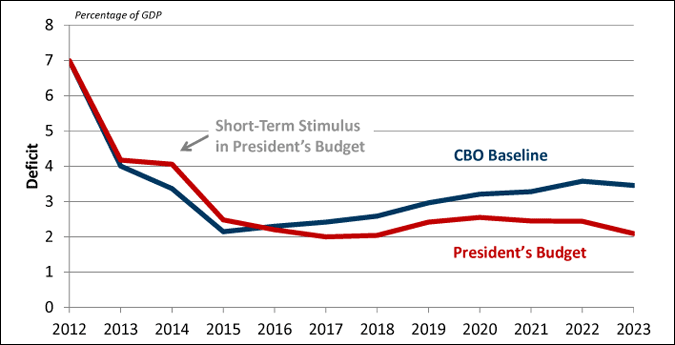
SOURCE: The Congressional Budget Office, An Analysis of the President's 2014 Budget, May 2013; and the Congressional Budget Office, Updated Budget Projections: Fiscal Years 2013 to 2023, May 2013. Compiled by PGPF.
CBO projects that federal debt under the President's budget would rise to 77 percent of GDP in 2014 before taking a gradual downward path to 70 percent of GDP by 2023. At that level, debt would be modestly below the 74 percent of GDP that CBO projects debt would reach if current laws were maintained.
Debt under the President's budget would be stable over the next 10 years, but remain high by historical standards
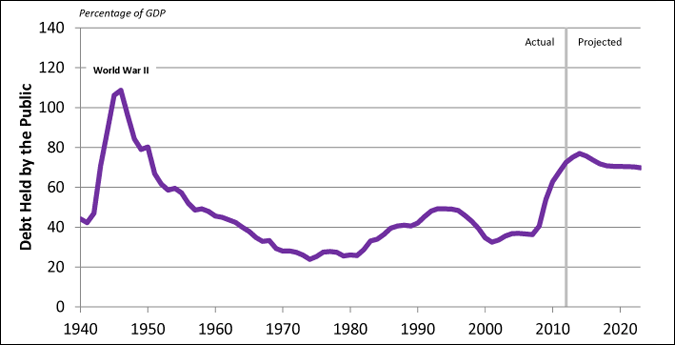
SOURCE: The Congressional Budget Office, An Analysis of the President's 2014 Budget, May 2013; and the Office of Management and Budget, Analytical Perspectives: Fiscal Year 2014. Compiled by PGPF.
However, by historical standards debt would still remain at a high level in 2023. Over the last 40 years, federal debt has averaged 39 percent of GDP and was as low as 36 percent of GDP as recently as 2007.
HOW DO THE PRESIDENT'S POLICIES AFFECT THE BUDGET?
The President's budget contains mostly revenue increases and some spending cuts. Of the $1.1 trillion of total deficit reduction under the President's budget, revenue proposals would account for $974 billion — 85 percent of the total. Another $80 billion of deficit reduction would come from the President's spending proposals. The remaining $92 billion stems from reduced interest costs on the debt.
On the tax side, CBO projects that under the President's proposals revenues would rise from 15.8 percent of GDP in 2012 to about 19.7 percent in 2023. This increase reflects both an improvement in the economy (which boosts taxable incomes) and the President's proposed changes to tax policy, which include capping the value of deductions and exclusions for higher-income taxpayers, increasing cigarette taxes, and changing the way certain tax provisions are indexed for inflation.
The indexing proposal would use a new price index (known as "chained CPI") to adjust the parameters in the tax code for inflation. It would also modify the cost of living adjustments used by many federal programs. Many economists believe chained CPI is a more accurate measure of inflation than the index currently in use because chained CPI accounts for the way consumers alter their purchases of goods and services when prices rise. Because chained CPI would grow more slowly than the current index, revenues would increase faster and benefits would grow more slowly over time than they would under current law.
On the spending side, the President proposes to cancel the automatic spending reductions that went into effect in March and reverse the sequestration in 2013 and the related spending cuts in subsequent years. The budget would replace those automatic cuts with other proposals that would reduce spending. His budget would also extend the statutory limits on discretionary spending for an additional two years, until 2023. Compared to current law, the budget would trade higher spending from 2013 to 2017 for lower spending in later years.
Besides canceling the automatic spending reductions, the other significant spending proposals include reducing funds for military operations in Afghanistan, lowering federal Medicare spending, and, as previously mentioned, adjusting the way major benefit programs are indexed for inflation. The President also assumes that emergencies after 2013 would be funded on an ad-hoc basis.
On average, both revenues and spending would be above their historical shares of GDP under the President's budget.
Both revenue and outlays would rise above historical averages under the President's budget
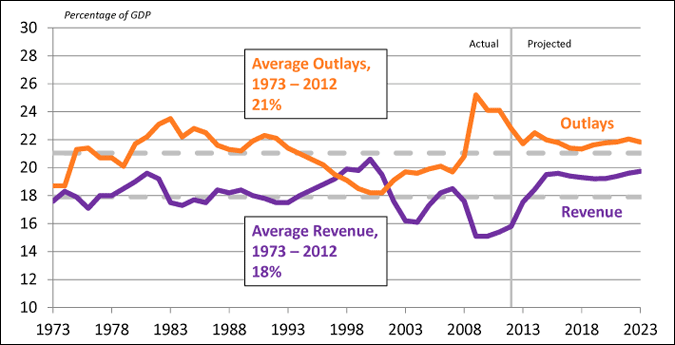
SOURCE: The Congressional Budget Office, An Analysis of the President's 2014 Budget, May 2013; and the Congressional Budget Office, Updated Budget Projections: Fiscal Years 2013 to 2023, May 2013. Compiled by PGPF.
COMPOSITION OF SPENDING
Although total spending would be roughly constant as a share of the economy in the coming decade, the composition of government spending would shift significantly.
The shift in composition of federal spending toward mandatory programs and interest continues under the President's budget
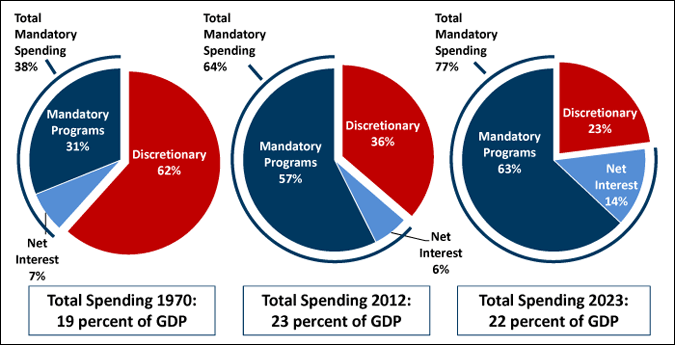
SOURCE: The Congressional Budget Office, An Analysis of the President's 2014 Budget, May 2013; and OMB, FY 2014 Budget, Historical Tables, April 2013.
NOTE: Mandatory programs include Social Security, major federal health programs, other entitlement programs, and offsetting receipts.
Under the President's policies, CBO projects that spending on mandatory programs would increase from 57 percent of all federal spending in 2012 to an all-time high of 63 percent in 2023. Meanwhile, CBO projects discretionary spending would shrink from 36 percent of total spending in 2012 to 23 percent in 2023. This category of spending includes defense and a wide range of government investment activities such as scientific research, infrastructure, education, law enforcement, national parks, NASA, food safety inspections, federal pay, and grants to state and local governments.
Compared to current law, the President's proposals would boost discretionary spending while the economy recovers through 2016, but tighten spending in the following years. By 2023, discretionary spending under the President's budget would be only 5 percent of GDP — well below its 40-year average and lower than it has been in any year since 1962. At such low levels, questions can be raised about whether the path for discretionary spending is economically realistic or politically feasible.
The President's budget reduces discretionary spending below CBO's baseline
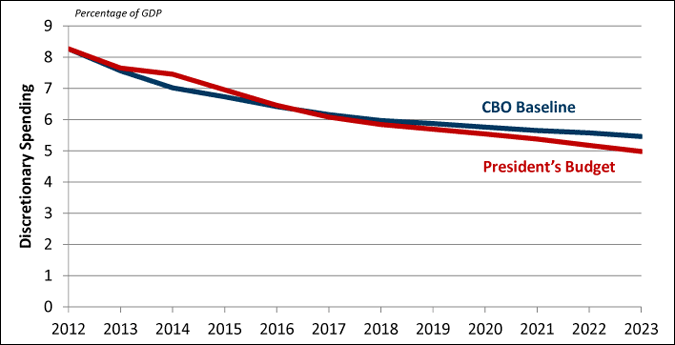
SOURCE: The Congressional Budget Office, An Analysis of the President's 2014 Budget, May 2013; and the Congressional Budget Office, Updated Budget Projections: Fiscal Years 2013 to 2023, May 2013. Compiled by PGPF.
The President also proposes numerous changes to Medicare. One proposal would create a new model for reimbursing physicians under Medicare. The proposal would avoid the 24 percent reduction in physician reimbursement rates that is scheduled to take place next year and would cost $139 billion over ten years. The President would also cancel the sequester of Medicare's resources at a cost of $81 billion over ten years. However, those costs would be more than offset by other Medicare proposals that save money.
On net, CBO estimates that the President's Medicare proposals would save $151 billion over ten years.1 Of that amount, structural Medicare reforms (which have the potential of "bending the cost curve") account for $93 billion. However, net Medicare costs under current law are projected to be $6.7 trillion over the same period, so these structural reforms would account for only 1.4 percent of total Medicare spending.
WHAT ARE THE LONG-RUN IMPLICATIONS?
In CBO's new report on the budget outlook, the agency warns of the risks of moving into the coming decade with high debt levels. As the economy improves, interest rates will rise back to more typical levels, increasing federal spending on interest payments and causing debt to rise further. If policymakers do not act, a large debt burden would crowd out private and public investments and slow economic growth. It would also limit policymakers’ flexibility in responding to unexpected challenges in coming decades and increase the risk of a fiscal crisis, according to CBO.
The President has proposed a budget that, if enacted, would take some steps in addressing these challenges. However, it leaves the debt at a historically high level in the 2020s and limits resources to invest in programs that encourage a stronger and more vibrant economy. Much more work will be needed to address these long-term challenges beyond the 10-year budget window. To have meaningful impact, policymakers will need to agree on a plan that truly addresses the long-term structural challenges our nation will face from the aging of our population and the growth of healthcare costs.
1This estimate includes the effects of chained-CPI on Medicare. (Back to citation)
